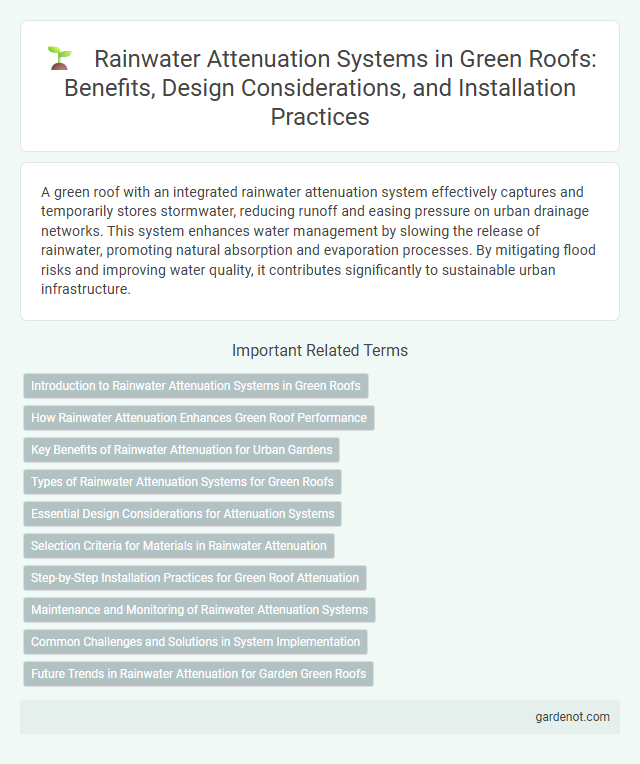A green roof with an integrated rainwater attenuation system effectively captures and temporarily stores stormwater, reducing runoff and easing pressure on urban drainage networks. This system enhances water management by slowing the release of rainwater, promoting natural absorption and evaporation processes. By mitigating flood risks and improving water quality, it contributes significantly to sustainable urban infrastructure.
Introduction to Rainwater Attenuation Systems in Green Roofs
Rainwater attenuation systems in green roofs manage stormwater by temporarily storing and slowly releasing rainfall, reducing runoff and mitigating urban flooding. These systems utilize layers of lightweight growing media, drainage mats, and retention chambers to capture and control water flow. Incorporating rainwater attenuation enhances the sustainability and efficiency of green roofs by balancing water absorption and drainage.
How Rainwater Attenuation Enhances Green Roof Performance
Rainwater attenuation systems improve green roof performance by managing stormwater runoff, reducing peak flow rates, and promoting gradual water release. These systems enhance the green roof's ability to retain and filter rainwater, mitigating urban flooding and decreasing pressure on drainage infrastructure. Effective rainwater attenuation also supports plant health by maintaining optimal moisture levels and preventing soil erosion.
Key Benefits of Rainwater Attenuation for Urban Gardens
Rainwater attenuation systems in green roofs significantly reduce stormwater runoff, mitigating urban flooding and decreasing pressure on municipal drainage infrastructure. These systems enhance water retention, promoting healthier urban garden ecosystems by providing consistent moisture levels and reducing soil erosion. Integrating rainwater attenuation supports sustainable water management and improves urban biodiversity through natural filtration and habitat creation.
Types of Rainwater Attenuation Systems for Green Roofs
Rainwater attenuation systems for green roofs include detention basins, modular tanks, and flow restrictors, each designed to control runoff volume and rate efficiently. Detention basins temporarily store excess water, reducing peak discharge during storms, while modular tanks provide underground storage for gradual release. Flow restrictors regulate outflow, optimizing water retention and minimizing flood risks in urban environments.
Essential Design Considerations for Attenuation Systems
Effective rainwater attenuation systems on green roofs require precise calculation of storage capacity to manage runoff volume based on local rainfall intensity and catchment area. Integration of high-permeability substrates and drainage layers ensures rapid infiltration and reduces peak discharge rates, preventing urban flooding. Selection of reliable overflow mechanisms and maintenance access points is critical for sustained system performance and longevity in diverse climatic conditions.
Selection Criteria for Materials in Rainwater Attenuation
The selection criteria for materials in rainwater attenuation systems prioritize high water retention capacity, durability under varying weather conditions, and environmental sustainability. Materials such as expanded clay, lightweight aggregates, and specialized foams offer optimal porosity and structural integrity to effectively capture and gradually release stormwater. Choosing eco-friendly and recyclable materials enhances the system's long-term performance while minimizing environmental impact.
Step-by-Step Installation Practices for Green Roof Attenuation
Install a layered rainwater attenuation system on green roofs by first placing a waterproof membrane followed by a root barrier to prevent plant intrusion. Add a drainage layer such as gravel or specialized mats to facilitate water flow and retention, then apply a water retention layer composed of lightweight substrates designed to absorb and store rainwater. Finish by planting vegetation suited for local climate conditions to enhance evapotranspiration and maximize the green roof's overall rainwater attenuation efficiency.
Maintenance and Monitoring of Rainwater Attenuation Systems
Regular inspection and maintenance of rainwater attenuation systems on green roofs ensure optimal performance by preventing blockages and structural damage. Monitoring includes checking inlet and outlet flow rates, sediment accumulation, and storage capacity to maintain effective water retention. Employing sensor technologies and routine cleaning protocols enhances system longevity and reduces urban runoff risks.
Common Challenges and Solutions in System Implementation
Rainwater attenuation systems in green roofs often face challenges such as inadequate drainage capacity, system clogging, and structural load limitations. Effective solutions include designing multi-layer filtration media to prevent blockages, incorporating overflow outlets for excess water management, and using lightweight, high-strength materials to reduce load impact on the roof structure. Regular maintenance protocols and precise hydraulic modeling during the design phase further enhance system performance and longevity.
Future Trends in Rainwater Attenuation for Garden Green Roofs
Future trends in rainwater attenuation for garden green roofs emphasize integrating smart sensor technology to optimize water retention and release based on real-time weather data. Advances in lightweight, high-capacity substrate materials improve rainwater absorption without compromising structural integrity. Emerging designs also focus on modular systems that facilitate easy installation and maintenance while enhancing ecosystem services such as biodiversity support and urban heat reduction.
Rainwater attenuation system Infographic

 gardenot.com
gardenot.com